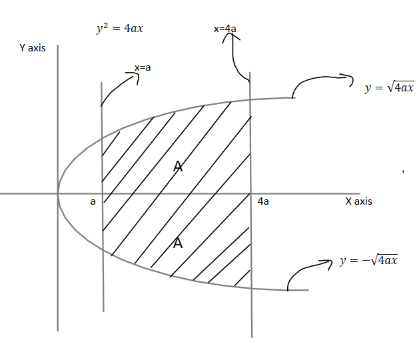Question
Question: Area inside the parabola \({y^2} = 4ax\) between the lines \(x = a\,\& \,x = 4a\) is equal to \( ...
Area inside the parabola y2=4ax between the lines x=a&x=4a is equal to
a)4a2 b)8a2 c)328a2 d)noneofthese
Solution
Area inside a parabola can be found using definite integration from x=atox=4a. As integration always gives area under the curve being represented. We have to integrate the function y=f(x)here y=4ax
Area =a∫4af(x)dx
Complete step-by-step answer:
Here, y=4ax
Area =a∫4af(x)dx
Area =a∫4a4axdx
Area =4aa∫4axdx { 4a is a constant and can be taken out of integration}
=4a21+1x21+1a4a =4a23x23a4a =324a(4a)23−(a)23 =324a8(a)23−(a)23 =32×7(a)23×4a =328a2squnits
Now this is the area of y=+4ax but not of y=−4ax which is also a solution of y2=4ax therefore to find the solution of either we can integrate or we can conclude that by symmetry it is also equal to =328a2squnits
It can be clearly seen by the plot of y2=4ax

Total Area =A+A=2A
Both graphs are symmetrical therefore total area equals to twice of area of y=+4ax
So total area of y2=4ax from x=atox=4a is equal to =2×328a2squnits =356a2squnits
So option D is correct.
Note: We have to take both y=+4ax and y=−4ax into consideration while always solving remember to simplify the equation to y=f(x) as only it can be integrated don,t use y2=4ax to be integrated. Use y′=4ax to be integrated. On parabola take symmetry into account along the respective axis. On integration area comes out to be negative we take the absolute value of area we can integrate f(y)=4ay2 to find the same solution but the procedure becomes lengthy and we don’t use this method.
